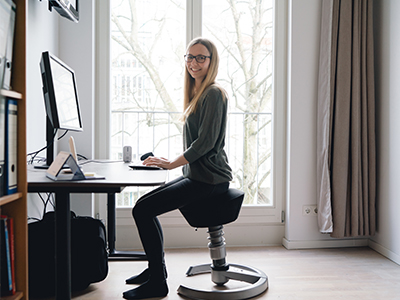How to Create an Ergonomic Workspace
How to Create an Ergonomic Workspace

It’s no secret; ergonomics is changing the way people do business. Studies show that utilizing ergonomics in the workplace leads to greater productivity, lower rates of injury, and overall enhanced well-being of the staff and business as a whole. But making this crucial change can be overwhelming. Where do you even start? Let’s focus on where all the action happens: the workstation. Follow these steps to improve your workspace with ergonomics.
Adjust Your Chair
The chair is where you spend most of your time in an office. It’s important to make sure it’s giving you the support you need as well as contouring to your body’s natural shape. If your seat causes discomfort, consider investing in an ergonomic chair. Take a look at the chair you’re using to see if it meets these ergonomic requirements:
Appropriate Seat Height
Your legs should ideally be at 90 degrees with your feet on the ground. Make sure your legs fit comfortably under the desk and aren’t angled too high or low. Aim to have your thighs parallel with the floor.
Well-Fitted Seat Pan
You should be able to fit 2-3 fingers between the back of your calves and the seat pan. If the seat pan is pressed against your calves, the seat is too big for you.
Backrest Support
The curve of the chair should fit the curve of your back in order to give you the proper back support. If you cannot adjust the backrest, consider purchasing a lumbar support pillow.
Recline, Tilt and Swivel Capabilities
Remaining stationary isn’t good for your body. Chairs that swivel, recline, and tilt keep your body in motion and allow you to change positions. Reclining also reduces pressure on the spine.
Comfortable Armrests
Armrests are optional, but if you do have them, make sure they fit your arm and shoulder’s natural rest position. Your elbows should be at a comfortable 90 degrees.
Choose the Right Desk
The desk you choose depends on the work you do and how long you spend at it. Here are some options:
Traditional Desk
For most people, a traditional desk will work just fine. But pay attention to the height. Too high and you’ll be straining your arms and neck; too low and you’ll be hunched over. Aim to keep your body at a 90-120 degree angle, including your back, arms, and legs.
L-Shape Desk
Maybe you have multiple monitors or have to go back and forth between physical writing and computer use. If your workstation requires a lot of surface area, consider an L-shaped desk instead of a deep or long desk. The L-shape will allow you to easily pivot between areas without putting strain on your arms, shoulders, and hips.
Drafting Table
Drafting tables are perfect for architects, illustrators, and anyone else who spends a lot of time physically drawing or writing. Leaning over a regular desk will cause hunching and aggravate the shoulders and neck. A drafting table tilts upward, bringing your head and body back to the ideal 90-120 angle.
Standing Desk
If you spend a prolonged time at your desk, a standing desk may be the best option for you. Instead of sitting motionless all day, a standing desk will keep your blood flowing and your body moving. Many ergonomic standing desks can be converted back to sitting desks so that you can alternate positions throughout the day.
Reposition Your Monitor
Your computer monitor should be an arm’s length away to avoid neck and eye strain. Your eyes should align with the top quarter of the screen so that your neck is positioned slightly downward. Some monitors have adjustable bases but you can also use monitor stands or a stack of books to achieve the proper height.
Reconsider Your Mouse and Keyboard
If your mouse and keyboard are on top of your desk, it may be time to switch to a keyboard tray. Some desks are already equipped with them but you can also purchase trays to attach to the bottom of your desk or chair arms. The idea is to keep your hands and arms as close to your lap as possible, maintaining a comfortable 90-degree angle. This will take the pressure off your shoulders and neck.
If you are using a laptop, consider buying an external mouse and keyboard. Engineers have reinvented the shape of computer accessories and there are plenty of ergonomic designs available. Split keyboards will keep your wrists in their natural position to help manage wrist pain or carpal tunnel. Computer mice and trackpads are more subjective so be sure to test a few designs to make sure they fit your hand and wrist movement.
Trust E3 Consulting to Create an Ergonomic Workspace for You
Apart from the basics, there are a variety of things that go into designing an ergonomic workspace. Every company and home office will have their own individual needs. The experts at E3 Consulting will work with you to come up with a plan to meet your goal and budget. The science is clear; ergonomics will improve your business. So give us a call and ask about our ergonomic programs and wellness training.

